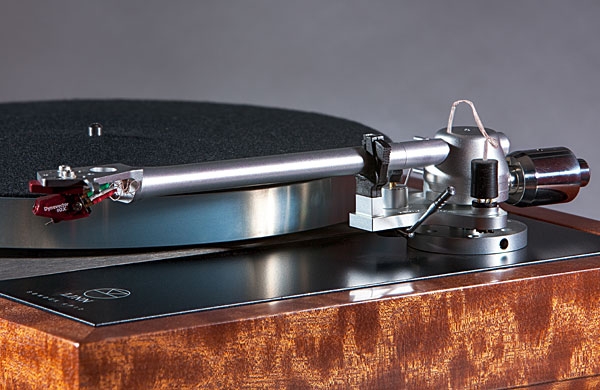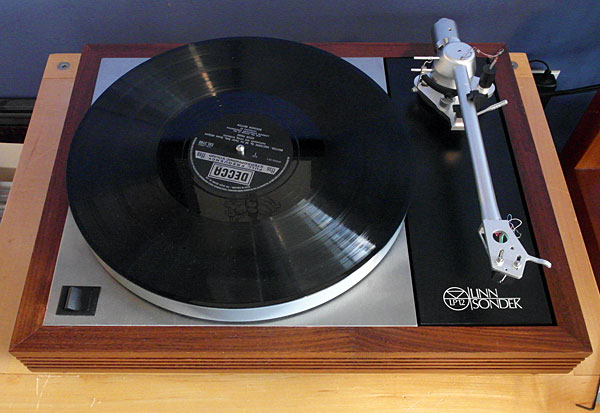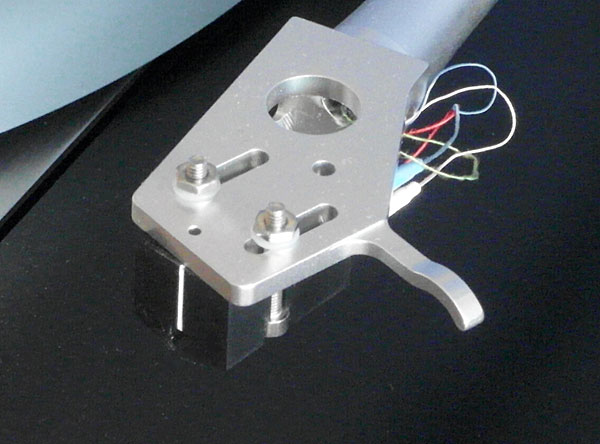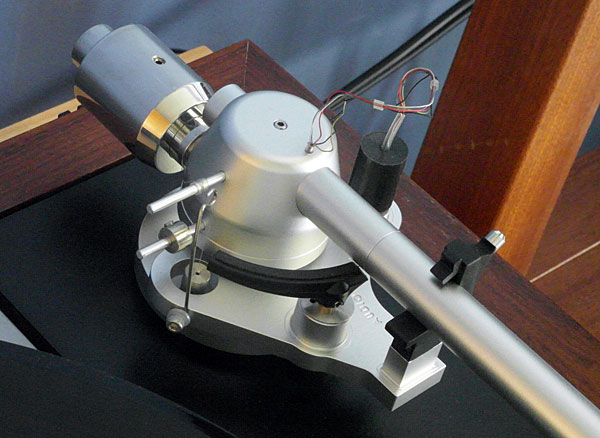| Columns Retired Columns & Blogs |
..about the Linn LP12...very alluring. I came close to buying one circa 1980 but the deal fell through. It's been Rega ever since..

So I scrapped my list—but not before noting that, on every version of it, the same product came out on top: the Naim Aro tonearm (footnote 1).
I owned a Naim Aro for a decade or more, and sold it only to help finance the purchase of something else—and then only because demand for the Aro, which Naim discontinued in 2006, had pushed asking prices irresistibly high. Yet I can't help regretting my decision: The Aro was, by a not-inconsiderable margin, the best-sounding tonearm I've ever used on a Linn Sondek LP12. It also allowed Bauer Audio's enduringly recommendable DPS turntable to sound riotously good.
And, to pile guess atop guess: The Naim Aro, with its low overall mass (its effective mass appeared to be more or less medium), might have been the perfect tonearm for the remarkable Roksan Xerxes turntable, whose 1998 replacement by the less-accomplished Xerxes 10 seems to have been occasioned, at least in part, by the fact that the original's arm-mount peninsula tended, over time, to sag under the weight of most other arms.
But I digress. These recollections were prompted by a phone call, last October, from Walter Swanbon, of the distribution and retail company Fidelis Music Systems. He wondered if I might be interested in reviewing "a modern replacement for the Naim Aro tonearm." Of course, I said "Yes," although I didn't mention that, in recent months, I'd been thinking of selling my Linn LP12, which I'd bought new over a quarter-century ago.
So that evening, I retrieved the LP12 from our upstairs guest room and gave it, along with my 1980s Rega Research RB300 tonearm and my relatively fresh Denon DL-103 cartridge, a complete going-over. Then I set about reacquainting myself with an old friend that had performed admirably for decades, mostly without complaint.
Getting it
The arm of which Swanbon spoke was the UniArm, designed and made by Scottish manufacturer Audio Origami, whose PU7 tonearm—a contemporary reimagining of the classic Syrinx PU3—had impressed Michael Fremer (footnote 2). The day the UniArm arrived, I did what I always do when I receive a tonearm: I stopped everything else I was doing in order to unpack, examine, and acquaint myself with the newcomer. I am, I confess, crazy about tonearms.

The UniArm, which seemed nicely made, has a lot in common with the Aro. Both are unipivot arms, and both use what I call a missionary bearing: a downward-pointing spike attached to the removable armtube, the spike sitting in an upward-facing cup on the stationary base. In both, the spike is tungsten steel, the cup sapphire. (Audio Origami suggests that the sapphire cup is the most expensive to make of the UniArm's parts.) Both arms are designed with miniature plugs and sockets for their signal wires, so that armtubes can be quickly and easily interchanged. The counterweight of each arm is mounted on a short rod below the point where bearing spike meets bearing cup, an arrangement that promotes cartridge stability. On both arms, antiskating force is provided by a monofilament thread and falling weight, and cartridge azimuth can be adjusted by means of a sliding weight that rides on a slender shaft affixed to the bell-like bearing housing.
But differences abound. Most notably, the UniArm's bearing cup is at the top of a post that's rigidly fixed in place, whereas the Aro's cup is cemented to the top of a steel post that rotates—stiffly, thanks to a thin coating of a silicone-like damping lubricant—atop a ball bearing. Absent an official explanation from Naim, consumers and critics alike are forced to guess at the reason for this extra bearing—a mechanical diode for dispensing with unwanted energies? a mechanical filter that resists conducting high-frequency noise?—and to wonder which, if any, of the Aro's musical and sonic characteristics can be laid at its doorstep.

There are other, lesser differences: The UniArm's aluminum headshell is made with two cartridge-adjustment slots of the usual sort, while the Aro's aluminum headshell famously offers only two holes for the mounting bolts for the cartridge of choice, with no means of adjusting overhang or lateral tracking angle. The structure by which the UniArm is mounted to a turntable is larger and more complex—and thus, presumably, more massive—than the exceeding small, simple base of the Aro. The UniArm incorporates a lift/lower mechanism for easy cueing, while the Aro, which lacks such a luxury, makes up for it with an elegant arm rest that makes it difficult, if not quite impossible, to damage one's cartridge by accidentally dropping the arm while cueing. The UniArm is available with two different combinations of arm-mount schemes and alignment geometries—to Linn's or Rega's specs—but it is not, in either version, a drop-in replacement for the Naim Aro, which had its own unique mounting scheme.

Finally, there are aesthetic differences: Most surfaces of the UniArm are hard-coat anodized with a colorfast finish—either silver or black—that looks quite nice (although the arm-mount area looks a bit busy); the Aro, in spite of sporting a slightly different shade of gray for each of its individual parts, somehow manages to look far more elegant, austere, and simple—almost Scandinavian.
The Audio Origami UniArm sells for $2495, which was the US retail of the Naim Aro ten years ago. A pretty good savings right there!
Getting it up and running
I requested and received the Rega version of the Origami UniArm, seeing as how Rega's RB300 is my go-to tonearm for my Linn LP12. (Fact is, now that I no longer own an Aro, and despite my flirtations with a vintage Decca International unipivot and my love for the review loaner of the AMG 9W2, the Rega is my only LP12 arm.) Swapping out the Rega arm for the UniArm took about an hour and a half—slightly longer than I'd expected, because I encountered a few wrinkles along the way.
First, the Rega RB300's mounting pillar—which is threaded to accept the arm's single, large locking nut, fitted from under the armboard—is 35mm long, measured from the flange that sits atop the armboard. The same part of the UniArm is perhaps 1mm shorter—and yet, during initial installation, that pillar was fouling against the right-rear gusset that's integral to the LP12's plinth. Because I'd never had trouble using an RB300 on a Linn, I wondered why an even shorter pillar wouldn't work—until I remembered that I always use at least one 2mm spacer between my Rega arm and the top of the armboard, to raise the arm and better approximate the vertical tracking angle (VTA) required by cartridges of average dimensions. (Rega's own moving-magnet cartridges are quite shallow, which I suppose is why the Rega arm, without 2mm mounting spacers, is so low-slung.)
Then I remembered something else: Packed with the UniArm is a plastic ring, looking for all the world like a checker with its middle drilled out. I measured it: just under 4mm thick, with an inner diameter of 24mm—just 1mm wider than the mounting pillar's diameter. Hmmmm . . .
You may have gathered by now that the installation manual supplied with the UniArm is sketchy. Its four pages contain a few good tips and a few good photos, but it's neither as thorough nor as helpful as it might be—something that Audio Origami themselves acknowledge in this qualification: "Full video instructions will be available soon."
Anyway, yes: The plastic ring was obviously meant for the job to which I applied it: raising the arm base a few millimeters above the armboard. The fouling described above was eliminated; still, while setting up the LP12, I had to go easy and not deflect its spring-suspended components too harshly or too far.
Footnote 2: See Mikey's "Analog Corner" in the November 2014 issue of Stereophile.

..about the Linn LP12...very alluring. I came close to buying one circa 1980 but the deal fell through. It's been Rega ever since..

Love the photos. Goes to show how the virtual format can supplement the written one.

Recently sold my TD-124 which Mr. Dudley still uses as a reference, and went back to a relatively new LP12 to replace one I sold 10 years ago and regretted selling. What can I say, like an old friend I hadn't seen in 10 years, picked off right where we left off. This tonearm review interested me as did getting an Aro for the table, but decided to go way out of left field and purchase a new SME IV. Call me crazy but I think it will work quite nicely.